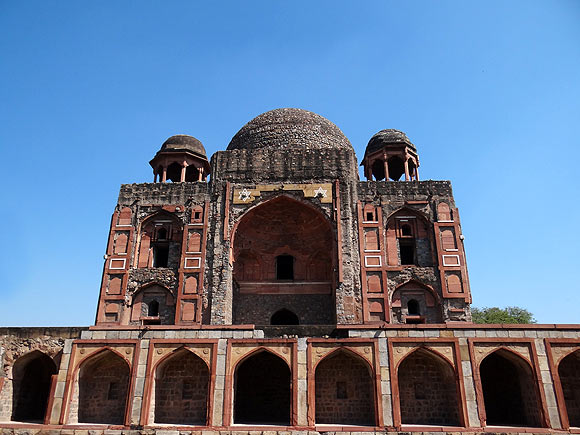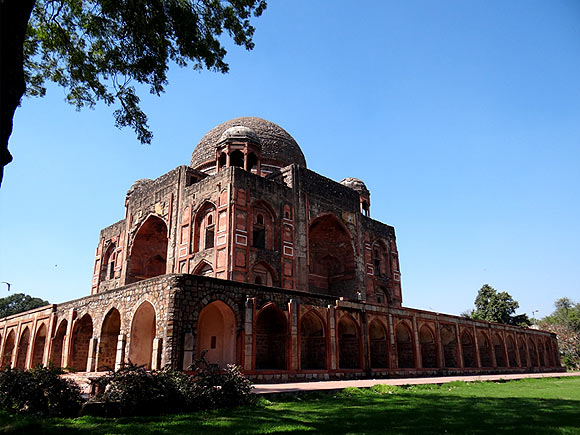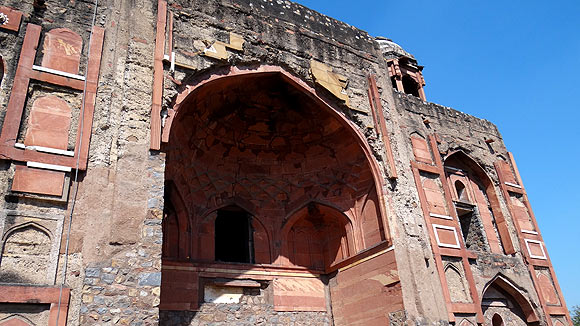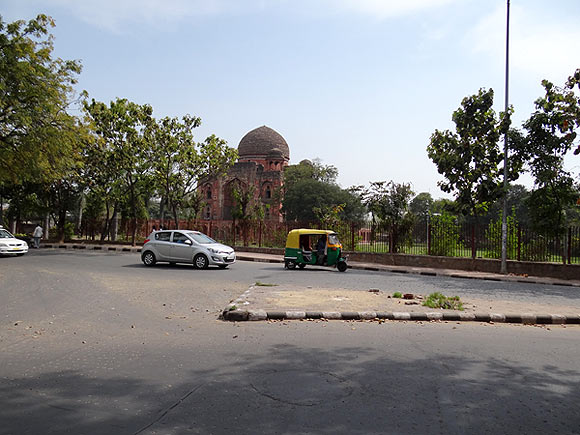Photographs: Nirdesh K Singh Nirdesh K Singh
The tragic and endearing tale of Abdul Rahim Khan's tomb.
Who can forget reciting dohe in our school Hindi classes? Dohe are short Hindi couplets conveying profound messages that draw meaning from everyday life for easy understanding. Apart from Kabir, another prolific dohe writer was Rahim. To understand the childhood connection with Rahim, we need to jog our memory to recall a popular doha:
Rahiman Dhaga Prem Ka, Mat Todo Chatkaya,
Toote Se Phir Na Jude, Jude Gaanth Pari Jaaye
It can be loosely translated in English as
Rahim says: Do not break the thread of love between people. If the thread breaks, it cannot be mended; even if you mend it there will always be a knot in it. The friendship will not be same anymore.
Now, that sure brought an instant childhood connection with Rahim and a smile to the face.
Khanzada Mirza Khan Abdul Rahim Khan-e-Khana (17 December 1556 -1627) popularly known as Rahim was one of the Navratnas (Nine Ministers or Nine Gems) in Akbar's court.
Abdul Rahim Khan was the son of Bairam Khan.
History is amazing -- how could a son of a Mughal general infamous for atrocities could turn out to be composer and poet.
Akbar who was probably sick of the overbearing and revolting Bairam Khan -- his tutor, regent and general -- retired him and sent him packing to Mecca. This was better than being thrown off the Agra Fort as Adham Khan would testify.
PICS: The fascinating history of the Khan-i-Khanan Tomb
Image: Khan-i-Khanan tombPhotographs: Nirdesh K Singh
On his way, in Gujarat, Bairam Khan was recognised by a certain man called Hazi Khan whose father was brutally killed by Bairam Khan during the Second Battle of Panipat between Akbar and Hemu.
Bairam Khan had exhorted the kid Akbar to behead Hemu as he lay bleeding from an arrow wound in the eye.
Bairam must have done something similar to this guy's father too. Anyway, Hazi Khan takes revenge and kills Bairam Khan. Maybe it was all planned by Akbar! However, Rahim Khan then four and his mother were released unharmed and they returned to Akbar's court.
Rahim Khan joined Akbar's court, regaled the court with his songs and poetry, rose through the ranks until he was promoted as one of the Navratnas and conferred with the title of Mirza Khan.
He was master of several languages like Persian, Chagatai, Sanskrit and Hindi. To augment his salary, he started writing Hindi Couplets for NCERT books. He was a contemporary of Tulsidas and both would exchange notes.
Although a Muslim, he was a devotee of Lord Krishna and wrote poetry dedicated to Him. The reason could be owing to his maternal lineage tracing back to Jadaun Rajputs and Yadavas.
PICS: The fascinating history of the Khan-i-Khanan Tomb
Image: Khan-i-Khanan tombPhotographs: Nirdesh K Singh
History again has a way of repeating unflinchingly in gory ways. Just like Rahim's father Bairam Khan tutored Akbar and was unceremoniously disposed off in an ambush in Gujarat for his efforts.
Rahim tutored Akbar's son Jahangir. For his efforts, Jahangir had Rahim's two sons killed and their bodies left to rot at Khooni Darwaza opposite Feroz Shah Kotla.
Jahangir was simply annoyed that Rahim supported Jahangir's eldest son Khusrau to succeed Akbar.
During his trips to Delhi, Mirza Khan marvelled at the beauty of the recently built Humayun Tomb. He figured that he would build something similar for his wife; just like Bu Halima did in her husband Humayun's memory.
Built in 1598, about 30 years after Humayun's Tomb, the structure and planning of Khan-i-Khanan Tomb are similar. However the latter is in on a much smaller scale.
The tomb, like Humayun Tomb is faced with red sandstone and white marble. The high dome has decorated plaster work. On his death Rahim Khan was also buried here along with his wife and sons.
PICS: The fascinating history of the Khan-i-Khanan Tomb
Image: Khan-i-Khanan tombPhotographs: Nirdesh K Singh
Mirza Khan's cenotaph lies on the first floor. The tomb was stripped of its sandstone and marble for building the Safdurjung Tomb -- a pattern repeated earlier by Sher Shah Suri who dismantled Siri Fort to build Shergarh and Shahjahan who walked away with Feroz Shah Kotla to build Shahjahanabad.
The chain of inspiration for building tombs for spouses continued and later Shahjahan taking a cue from Rahim Khan built a popular tomb in Agra for his wife.
Today, the Khan-i-Khanan Tomb sits on prime real estate in East Nizamuddin. The lawns are lush and well maintained. Since it is a ticketed monument and that too in the shadow of Humayun Tomb, it does not get many visitors.
Most people driving on the busy Mathura Road are too busy negotiating the traffic to look. Few who do, look at the tomb with some bewilderment. People are not sure what to make of the stripped exterior.
The tomb looks like a once rich person who has been dealt a bad hand and all that is left now is a tattered coat and some old glory. It looks tragic and at the same time endearing -- just like Rahim's life.
Come and spend some time among the scarred and stripped walls. You just might hear poetry and couplets wafting in the air.
Getting There: As you drive on Mathura Road from Subz Burj roundabout towards Nizamuddin Railway Station, the tomb lies on the left.





Comment
article